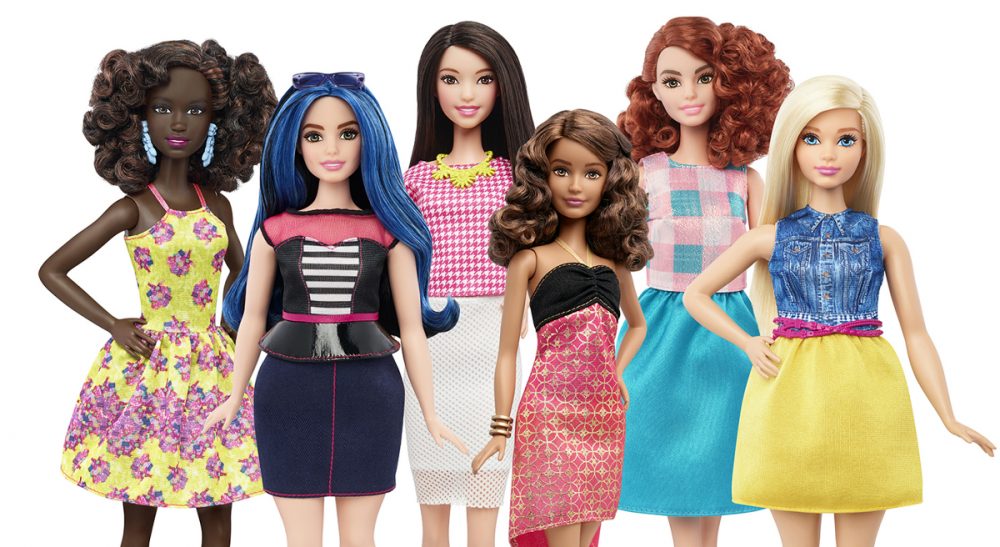Advertisement
#TheDollEvolves: What Barbie's New Body Can — And Cannot — Do For Our Girls' Body Image

Last week, Mattel announced a new line of Barbie dolls, complete with a new hashtag: #TheDollEvolves. The dolls have one of three “real woman” figures -- curvy, tall and petite. The new bodies are outfitted with various skin tones, hair colors and hair textures, so that when kids peruse the Barbie aisle, they will see dolls resembling the real people in their lives. This is Mattel’s latest attempt to increase their bottom line, to win back the fandom of families, and to give Barbie more realistic features and proportions. Of course, the standard white, thin, blonde and busty Barbie will still exist, but now kids (and parents) have a more diverse set of options when choosing which doll to take home.
[Time magazine] put several 6-year-olds in a room with the new dolls and watched them play through a two-way mirror. What happened is disappointing, but not surprising: Curvy Barbie was undressed, called fat and laughed at.
It’s helpful that Mattel is expanding the diversity in their doll line, but I’m not convinced that the new Barbie will sell. Consider Time magazine's observational study, which put several 6-year-olds in a room with the new dolls and watched them play through a two-way mirror. What happened is disappointing, but not surprising: Curvy Barbie was undressed, called fat and laughed at.
Perhaps it’s the media, the airbrushing, the ads for diet pills, the way we pinch our tummy fat in front of our kids and self-deprecate. Who knows? One thing is for certain: Our kids are on to us. They mimic what they see, and they repeat what they hear. Blonde is sexier than brunette; light skin is more attractive than dark; blue eyes have more depth than brown; skinny is more desirable than full-figured.
By the time girls are 5 years old, they are indoctrinated with these constructs of beauty and desirability and report anxiety about their own appearance. By the time they are 10 years old, 81 percent of girls are afraid of being fat. A reported 40 to 70 percent of middle school girls are dissatisfied with two or more parts of their body.
I see this mirrored in my adolescent clinical practice. Teens aspire to a prepubescent look with breasts. Girls want the slender nature of their previously underdeveloped body with the breasts of an augmented celebrity, a look akin to an anime character, or the original Barbie. A look inspired by fantasy, not reality, leaves no room for confidence in their natural, developing appearance.
As a health care provider, I’ve seen body image insecurity taken a step further, with girls undergoing breast augmentation while still in high school. Even more distressing: labiaplasty, or the trimming of a woman’s labia. The practice has become so mainstream, teenagers in my practice ask me about it. Girls want to know, are my labia normal? Are they pretty or ugly? If I think my labia are too big can I have labia surgery before college? This is light years beyond a fear of being fat; it’s body perfection — and obsession — taken to an unhealthy extreme.
Teens aspire to a prepubescent look with breasts. Girls want the slender nature of their previously underdeveloped body with the breasts of an augmented celebrity...
It's a step in the right direction for Mattel to offer Barbie in various shapes and sizes. Unfortunately, offering better “doll” role models for kids won’t cut it. We, the adults, need to be their role models. While we can’t protect them from airbrushed advertising, the surgery options they stumble upon online, or the body shaming talk of their peers, we can show them what it means to be a confident adult.
Our children need to see us smile at our own reflection and at the shape of our natural figures. If I can look in the mirror and see my soft and squishy belly -- the body that gained and lost 50 lbs with each of my pregnancies -- as incredible, I will teach my children to respect their bodies. If I can put the scale away for only periodic checks, I will teach them that weight is not to be obsessed over. If I can rock my bathing suit without worrying about my thighs or small chest, I will teach my kids that confidence doesn’t just come with having a figure like Giselle's.
There may yet come a day when my little girl walks down the doll aisle of a toy store proclaiming that she wants skinny, blonde Barbie, because that’s the “pretty” one. I hope I navigate that well. In the meantime, I’ll do my best to show her what it means to be confident in her own skin. I also pray that through the years, as I tell her she’s beautiful just the way she is, it settles into her heart as an unshakable truth.
